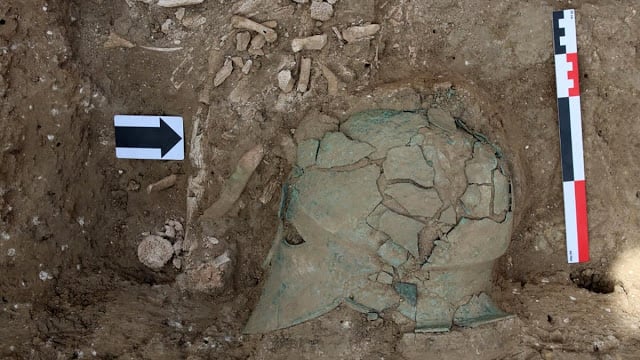
An ancient Greek Corinthian helmet was found recently in a fifth-century BC grave in the Taman Peninsula in southwest Russia.
Made of bronze, ancient Greek Corinthian helmets covered the entire head and neck, with slits for the eyes and mouth, protruding cheek covers (paragnathides), and a curved protrusion in the back to protect the nape of the neck.
The helmet has a padded interior made of fabric or leather to protect the warrior’s skull. These helmets were essential for the Greek hoplites, the famous foot soldiers of the phalanxes.
While the Corinthian helmet is named after the ancient Greek city-state of Corinth, where it originated, it was used across Greece in ancient times from the sixth century to the first, when it fell out of fashion.
Ancient Greek Corinthian helmet found in Russia
The helmet found in Russia is corroded and highly fragmented, but its discovery is extremely important for historical purposes. The Corinthian helmet found in southwest Russia is the only one of its kind discovered north of the Black Sea.
Corinthian helmets appeared in Greece around the 6th century BC and is one of the symbols of ancient Greece. The goddess Athena and the famed Athenian statesman Pericles are both frequently depicted wearing them in ancient Greek art.

In antiquity, when a warrior died, his helmets would be buried next to him. According to Roman Mimohod, director of the expedition of the Institute of Archaeology of the Russian Academy of Sciences (IA RAS), “the helmet of the Taman peninsula belongs to the Corinthian Hermione-type and would date back to the first quarter of the fifth century BC.”
Greeks settled across the area
The Kingdom of the Bosporus was established in 480 BC around the Kerch Strait and the Taman Peninsula west of the Bosporus.
The kingdom, with Panticapaion as its capital, lasted almost a millennium, with the last written traces stretching back to the 5th century AD.
It was a place where Greek culture merged with successive nomadic cultures of the steppe, be it the Scythians or the Sarmatians. Between the 6th and 3rd centuries BC, Greeks and Scythians maintained extremely close cultural as well as commercial ties.
Several Greek colonies were established in the region. Their settlement extends from the end of the 7th century BC to the second quarter of the 4th century BC.
The Greeks founded large cities on the northern coast of the Black Sea. The main ones were Olbia at the mouth of the Dnieper, Panticapaion, today’s Kerch, in the extreme west of the Crimea, and Chersonese (Sevastopol) on the Russian bank.
One of the ancient Greek settlements in the area, Phanagoria (Taman), also gave name to to the peninsula where the Corinthian helmet was discovered.
See all the latest news from Greece and the world at Greekreporter.com. Contact our newsroom to report an update or send your story, photos and videos. Follow GR on Google News and subscribe here to our daily email!



